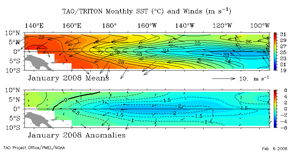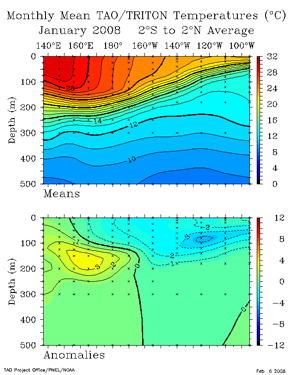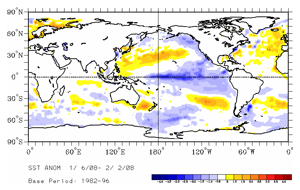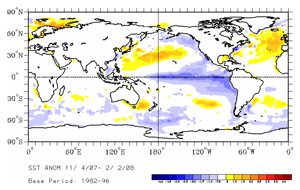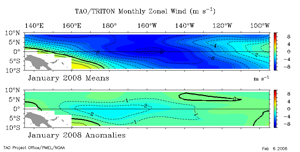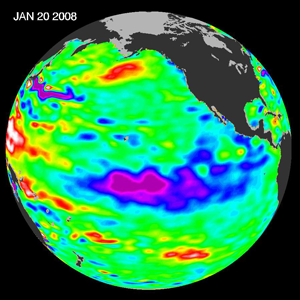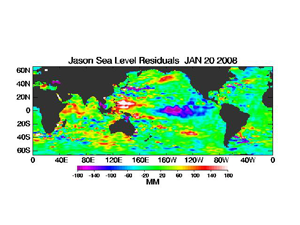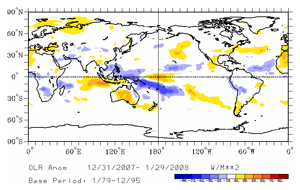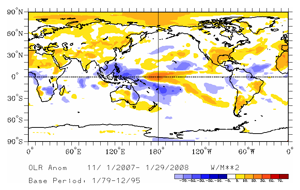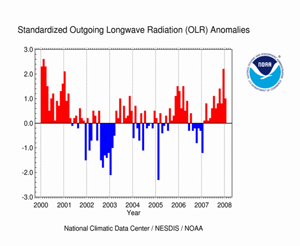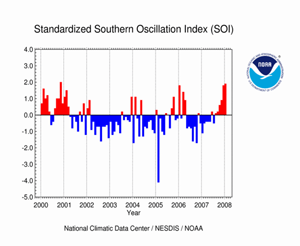LA NIÑA CONDITIONS INTENSIFY:
SSTs CONTINUE TO COOL ACROSS CENTRAL EQUATORIAL PACIFIC
Sea Surface Temperatures (SSTs) and Mixed Layer Conditions:
The area of sea surface temperature (SST) anomalies colder than -1.5°C (-2.7°F) moved westward and intensified during the month, with the coldest anomalies from approximately 170°E to 130°W in January. Water temperatures in the mixed layer also decreased in January, with an area of -2.0°C (-3.6°F) and colder temperature anomalies between 50 and 150 meters depth of the mixed layer in the eastern equatorial Pacific. Warmer-than-average temperatures remained in the mixed layer in the western equatorial Pacific this month, primarily west of the Dateline.
For the month, the SST anomaly in the Niño 3.4 Index region was -1.77°C (-3.19°F) in January, which was a decrease of 0.45°C (0.81°F) compared to the December anomaly. The SSTs in the Niño 4 Index region of the western equatorial Pacific also cooled during January to a monthly anomaly of 1.27°C (2.29°F) below the mean (map of Niño regions). For the most recent global ocean surface temperatures, please see the loop of satellite-derived weekly SST anomalies for January 2008.
Significant cooling of the SST anomalies in the Niño 3.4 index region over the past two months kept the 3-month running mean well below -0.5°C (-0.9°F) in January, which is the Oceanic Niño Index (ONI) threshold for a cold event (NOTE: For NOAA's official ENSO classification scheme, please see NOAA's El Niño/La Niña Index Definition).
The Climate Prediction Center's most recent ENSO Diagnostic Discussion indicated that the cold event (La Niña) had reached maturity at the end of 2007, and the SST anomalies have cooled during the month. The ENSO Wrap-Up from the Australian Bureau of Meteorology (BoM) also reflects the maturing of cold event conditions in the tropical Pacific basin, which they forecast to persist for the first few months of 2008 (see the Australian BoM ENSO Wrap-Up).
Equatorial Zonal Winds (U-Component Winds) and Sea-Level Topography:
Anomalous easterlies (i.e., trade winds) were observed across the western equatorial Pacific during January, while in the central and eastern equatorial Pacific the trade winds were near-normal for the month.
Significant week-to-week variability in the near-surface winds has been observed along the equatorial region of the Pacific over the past month, as shown in the loop of January zonal winds. A period of anomalous westerly flow occurred in the eastern Pacific during mid-January, as the easterly trade winds weakened in the equatorial zone.
Pacific sea levels measured by the NASA/JPL Jason-1 satellite were below average across the central equatorial Pacific in January, reflecting the cooler-than-average ocean temperatures and the mature phase of the La Niña event. The positive sea level anomalies have moved slowly westward over the past couple of months (see the most recent loop of Pacific basin sea level anomalies).
Outgoing Longwave Radiation (OLR):
The map on the left below shows the spatial pattern of global OLR (in W m-2) measured by satellite during January. A large region of positive OLR anomalies was observed in the western equatorial Pacific near the Dateline, illustrating the suppressed tropical convection in this region. The lack of convection along the equator and near the Dateline has persisted for several months, which is clearly seen in the 3-month average OLR anomalies (below right).
The monthly OLR index for January was +1.0 W m-2 averaged across an area in the western Pacific between 160° E and 160° W. This was the twelfth consecutive month that the OLR index had a positive monthly value. Persistently high positive OLR indices are typical of the mature phase of a La Niña episode.
As of early February, NOAA's Climate Prediction Center (CPC) has forecasted the current La Niña episode to continue through the Boreal spring (March-May) 2008 (click here for CPC's ENSO Diagnostic Advisory Archive). Therefore, it is expected that the monthly OLR indices will eventually decrease toward neutral (i.e., zero), as the cold event in the equatorial Pacific begins to weaken over the next several months.
Note that high frequency variability in OLR is typically associated with the Madden-Julian Oscillation (MJO, which is convective activity that propagates west to east in the near-equatorial region from the Indian Ocean into the Pacific Ocean approximately every 30-60 days). The latest MJO activity can be seen in CPC's graphs of Daily MJO Indices.
Southern Oscillation Index (SOI):
The standardized SOI was +1.9 in January, which was the highest monthly SOI of the 2007/2008 La Niña so far. Overall, January was the sixth consecutive month with a positive index value [consistently positive (negative) values of the SOI are typical of La Niña (El Niño) conditions].
Therefore, the persistence of positive monthly SOI values, along with the high monthly SOI values in December and January, indicate that the La Niña has entered its mature phase across the equatorial Pacific basin.
Additional Links
- ENSO Monitoring
- NOAA El Niño / La Niña Index Definition
- NOAA's Pacific Marine Environmental Laboratory (PMEL):
- NOAA's Climate Prediction Center (CPC):
- NOAA's Physical Science Laboratory
- NASA/JPL Ocean Surface Topography from Space
- Australian Bureau of Meteorology (BoM) Climate Driver Update
- IRI - International Research Institute
 NOAA's National Centers for Environmental Information
NOAA's National Centers for Environmental Information
